Pharm Exec's Annual Press Audit 2016
George Sillup and Stephen J. Porth identify the “hot button” issues attracting media attention in 2015.
The results of our Annual Press Audit of issues in the pharmaceutical industry indicate that the media’s scrutiny of pharma declined in 2015 for the first time in four years – but is still almost double what it was in 2011. Our audit identified 159 articles this year, a decrease of almost 19% from last year. The drop off in coverage was across the board in the major newspapers we audit with the exception of the Wall Street Journal where coverage was up by over 18%. Research & Development of New Products earned the top spot on the list of hot button issues this year, followed by Drug Safety and High Drug Prices.
The 12th annual audit sponsored by the Arrupe Center for Business Ethics at Saint Joseph’s University tracks and analyzes the industry issues covered by the media. Prior audits have found that media coverage is largely negative toward the positions taken by pharma. This year’s audit identifies the “hot button” issues attracting media attention in 2015, compares the issues and how they are covered to previous years, and reports on the pharmaceutical companies and brands most often cited in the news. We also updated our analysis of how healthcare reform has been reported by the press. This year, for the first time, we supplement our audit of major newspapers with initial analyses of transcripts of national network news broadcasts and searches on Google Trends and LexisNexis. By using these sources, we add a new element to our research, social listening and assessment of coverage by other media, such as radio and television. The sources allow us allow us to track the same search terms over the same time period to learn whether the same “hot button” issues are identified and the scope of that coverage.
Some of the top findings for 2015 include:
• Coverage of the industry had been trending up but was down this year, decreasing by 18.9% from last year to 159 articles.
•The hot button issues attracting the most attention in 2015 were, in order of frequency, R&D for new drugs, drug safety and high drug prices. Ebola emerged as the fourth most covered topic with virtually no coverage in prior years.
• Coverage about Healthcare Reform was half of what it was last year decreasing form 60 to 30 articles. This was not surprising during the lull before the presidential campaigning and debates; most significantly the New York Times went for 30 to eight (8) articles.
• Media coverage of the industry continues to be more critical than positive or neutral. In 2014, 44.7% of articles were negative toward the industry compared to the five-year average of 41.4%.
• Newly emerging issues in 2015, appearing on the hot button list for the first time, were vaccinations, mergers and acquisitions, antibiotic resistance and lethal injections.
• Of the 30 healthcare reform articles, the neutral tone of last year’s audit was replaced by a negative tone; three of the five papers were more negative than positive except for the New York Times, which was the most positive it has been in the past five years.
Processing the news
Once again we analyzed the top five newspapers in the United States as defined by circulation for a 12-month period and identified all front-page and editorial articles pertaining to “hot button” pharma issues. The purpose of the audit was to shed light on the following questions:
§ What ethical and legal controversies face the pharma industry-and what kinds of coverage do they attract?
§ Do the articles and headlines support or oppose the positions taken by the industry, as defined by the Pharmaceutical Research & Manufacturers’ Association (PhRMA)?
§ How often do reporters include the industry’s perspective in the stories that cover the issues of the day?
§ What pharmaceutical companies and brand names are identified and discussed in the articles?
§ What are the implications of these findings for the industry?
To be included in the study and in our EthicsTrak database[1], an article had to be published between October 1, 2014 and September 30, 2015 in one of the top five US newspapers (as measured by circulation) – USA Today, Wall Street Journal, New York Times, Los Angeles Times, and the Washington Post. It also had to (a) focus on an ethical or legal issue facing the pharma industry and (b) appear either as a front-page story or on the editorial page-an indication of major news and public sentiment. We focused on daily newspapers rather than the broadcast media or weekly magazines for a number of reasons. The newspapers cover a broader range of issues and in more depth than the sound bites reported on radio and TV. Business and news magazines are also constrained by their weekly or monthly formats while the newspapers have the advantage of editorial coverage that takes a specific and unambiguous position – pro or con – toward the controversies in question.
For each article, we examined four elements:
Issues We identified and categorized the hot-button issues that were discussed in each article. Many articles covered two or more issues that were included in relevant sections.
Headlines We analyzed the headlines and categorized them as positive, negative, or neutral toward the industry. For example, “As Researchers Develop Ebola Vaccine, Early Human Clinical Trials Show Promise” (Washington Post, October 23, 2014) and “Drug to Fight Heart Attack Clears Panel” (New York Times, June 10, 2015) were classified as positive headlines, while “Sneaky Ways to Raise Drug Profits” (New York Times, June 8, 2015) and “Drug Cited in Deaths at Nursing Homes” (Washington Post, July 13, 2015) were labeled positive.
Tone We also analyzed each complete article to determine whether it took a positive, negative, or neutral position toward the pharmaceutical industry. For example, any article that called for restrictions or a prohibition on DTC advertising-a position that the industry opposes-was deemed negative. In contrast, an article that claimed that DTC advertising resulted in more informed patients was designated as positive from the industry’s point of view.
Balance Regardless of the dominant position taken by the article, we also looked to see if the stories included the opposing point of view. When an explicit statement about an opposing view was included in the article-even if the two sides did not receive equal coverage-we concluded that the article covered both sides. When no mention of the opposing view was presented, the article was labeled as one-sided.
Figure 1 shows the number of articles for 2015 compared to previous years. Results indicate that the amount of coverage the industry received is down 18.8% year over year but remains well above the five year average of 137 articles.

Table 1 below shows the breakdown of coverage by newspaper. The 18.9% decrease in coverage of the industry for the year reflects decreased coverage across all of the newspapers, with the exception of the Wall Street Journal. Most notable is the plummet in coverage by USA Today, from 17 to 2 articles. USA Today is typically light on coverage of the industry compared to the other major newspapers but their 2015 coverage was almost nonexistent.
Table 1 – Number of Articles by Newspaper and Year
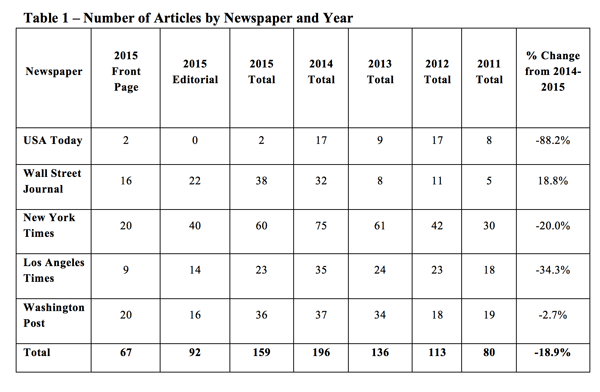
What are the hot button issues?
Table 2 identifies the issues covered in the articles, the frequency of their coverage, and how the results compare to previous years. Three issues that were at the top of the list last year, R&D for new drugs, drug safety and high drug prices in the U.S., remain there although their order has changed. At the top on the list this year, moving up from second place last year, was research & development of new drugs. This coverage is typically good news for the industry as it often emphasizes progress made on promising new drugs. Examples include “Scientists Study Miracle Patients' Genes for Wider Cancer Therapies” (Washington Post, June 14, 2015) and “Race Is On for Ebola Drug” (Wall Street Journal, October 18, 2014).
Second on the list of topics attracting media attention is drug safety, an issue that has held the number 1 or 2 spot on the list in seven of the last eight years. Despite its high ranking, the actual number of articles we identified and tracked on drug safety plummeted from 63 articles last year to 23 in 2015. That decline is good news for the industry as this topic typically signals bad news for the industry. Examples include “Opioids Prescribed by Doctors Led to 92,000 Overdoses in ERs in One Year” (Los Angeles Times, October 27, 2014), “Safety, Sanitary Problems Prompt Scores of Drug Recalls” (USA Today, October 7, 2014) and “Heartburn Drugs Linked to Higher Heart Attack Risk” (Washington Post, June 11, 2015).
High drug prices in the U.S. ranks third on the list this year, a topic that attracts media scrutiny each year. The Wall Street Journal reported on a “Small Number of Drugs Drive Big Medicare Bill” on May 1, 2015 and the Washington Post focused on high drug prices in “Protect Our Access to Medicine” (June 7, 2015).
The Ebola virus emerged as a hot topic last year and remained on the list again this year, moving up to fourth place. The New York Times raised a sense of urgency in “Ebola Vaccine: The Need to Act Now” (August 3, 2015) and the Wall Street Journal raised hope in “Race Is On for Ebola Drug” (October 18, 2014) and days later tempered hope with frustration in “Ebola Vaccine Push Ramps Up: After Years of Delay, Researchers Rush to Field Test a Shot to Prevent the Disease” (October 20, 2014).
Interaction with the FDA is another topic that makes the list each year, retaining its spot in fifth place on the list. The Wall Street Journal which, of the five newspaper we audit, is most likely to support the views of the industry reported on “How to End the Regulatory Slowdown for New Antibiotics” (July 3, 2015). In contrast, the New York Times reported on “Don't Rush Drugs to Market” (June 11, 2015).
Other issues that were perennial hot button issues in the past such as DTC advertising and marketing and sales incentives attracted very little attention this year, too little to make the list. This lack of coverage is a positive outcome for the industry, and may reflect a general familiarity with and acceptance of drug advertising campaigns and new policies and procedures in place to regulate incentives to physicians.
Table 2 - Analysis of Ethical Issues

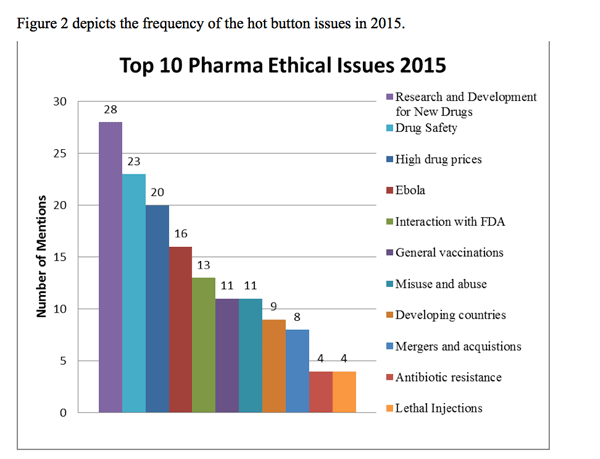
Identification of pharma companies
Mentioning a pharmaceutical company by name or referencing one of a pharmaceutical company’s products is a clear association between that company and an ethical issue. For the four consecutive years, the number of mentions increased. Last year there were 455 mentions about 24 companies and/or 61 products. This year the number of mentions decreased for the first time in five years but there were still 148 mentions of pharma companies and/or their products. Heading the list was Sprout/Valeant with 14 mentions. This was due to Sprout’s launch of Addyi®, the first and only FDA-approved treatment for acquired, generalized hypoactive sexual desire disorder (HSDD) in premenopausal women (Viagra® for women) and Sprout’s subsequent acquisition by Valeant. Nine other companies had six or more mentions. These include Merck (8), Johnson & Johnson (7) and GlaxoSmithKline, Amgen, Teva, Pfizer, Novartis, Mapp Pharmaceuticals and Chimerix all with six mentions. Attention was given to Mapp for its work on Ebola and to Chimerix for its Phase 3 clinical study failure of its cytomegalovirus drug, Viread® (brincidofovir). This year the 148 mentions of companies or their products also had 62 companies with one mention, the highest since this audit was started.
Coverage
Our twelve-year analysis has found that the tone of headlines and articles tends to be more negative than positive for the industry. While that trend continues, this year headlines were less negative than last year and the articles themselves were slightly more positive. Table 3 shows these results. There has been an uptick in positive articles over the five year period, from 17.5% in 2011 to 36.5% this year, with a corresponding drop in articles that were neutral to the industry.
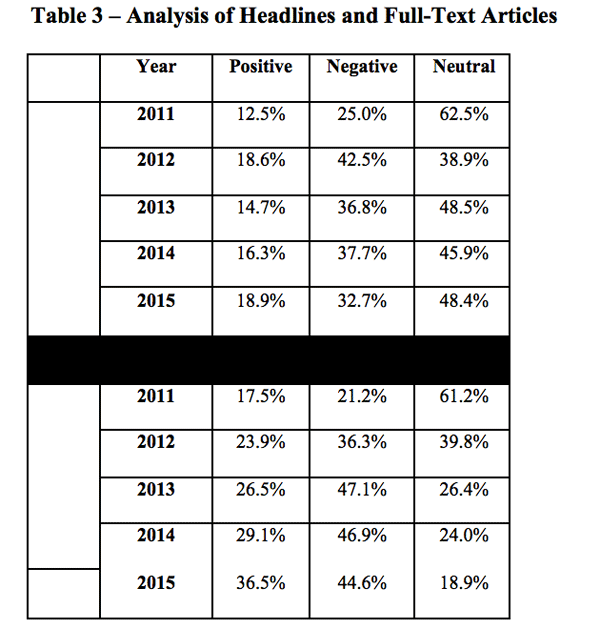
Regardless of whether the article takes a primarily positive or negative tone toward the positions of the industry, our audit analyzes whether both sides of the disputed issue are at least acknowledged. This year 52.8% (84 of 159) of articles mentioned both sides, an increase from last year’s mark of 49.0%.
Analyzing newspaper coverage about healthcare reform
Consistent with prior years, we analyzed the same U.S. newspapers we assessed to identify ethical issues affecting the pharmaceutical industry to identify coverage about healthcare reform by addressing the following questions:
§ Do the healthcare articles and headlines support or oppose the positions taken by the pharmaceutical industry?
§ What ethical issues face the pharma industry in these articles on reform?
§ How often are the industry’s perspectives included in the articles?
§ What pharmaceutical companies and/or brand names are identified in the articles?
§ What are the implications of these findings for the industry?
Coverage about healthcare reform decreased
Healthcare coverage this year was half of what it was last year or 30 vs. 60 articles, the lowest number of healthcare reform articles since 2012. The decrease in coverage is not surprising during the lull period before the presidential primaries and no new major issues with the implementation of the Patient Protection and Affordable Care Act (PPACA or Obamacare). Coverage in all papers decreased except for the Wall Street Journal, which increased by one article. Most significantly, the New York Times decreased from 30 to eight (8) articles (a 73.3% drop). Only the USA Today had more front-page articles than editorials. Please see Table 4 below for comprehensive details.
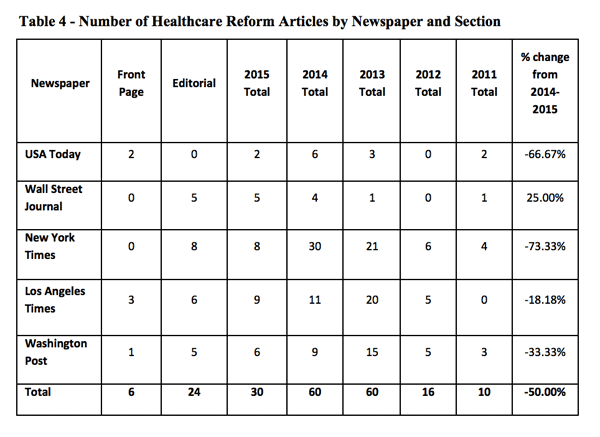
Healthcare reform ethical issues identified
As with coverage in all previous years, healthcare reform was the most reported issue 3with 14 mentions. This was followed by high drug prices with six (6) and a number of issues with two and one mentions, such as Medicare/Medicaid and Drug safety. This is consistent with the decrease in overall coverage and, similarly, not surprising due to the lull before the upcoming presidential campaigning and debates. Table 5 below has a breakdown of the ethical issues related to healthcare reform

Comparing the healthcare reform headlines and articles
The headlines as well as the articles were analyzed as positive, negative, or neutral toward the pharmaceutical industry. Unlike the neutral tone of last year’s audit, this year there was definitely a negative tone. For both the headlines and articles, there was the highest percentage of negative articles. Headlines increased form 28.3% last year to 30% this year and articles increased from 28.3% to 33.3%. Furthermore, there were only 3.3% positive headlines but 26.7%t positive articles. These results are compared to the past five and depicted in Table 5a below.
Table 5a – Analysis of Healthcare Reform Headlines and Full-Text Articles
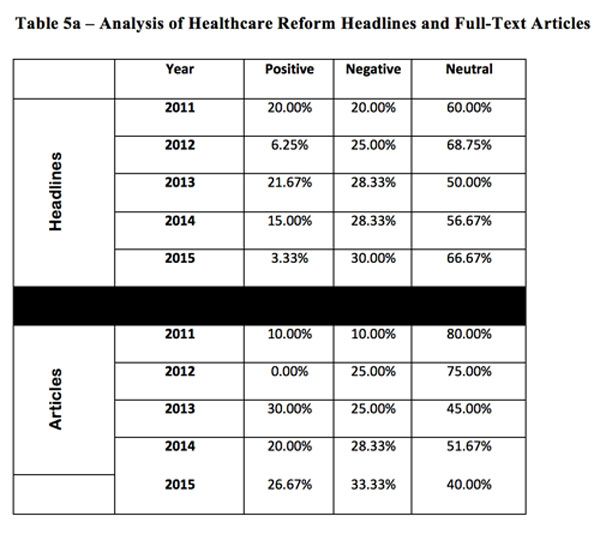
When coverage by individual newspaper was assessed, three of the five papers, the Wall Street Journal, the Los AngelesTimes and the Washington Post, were more negative than positive. It was the most positive the New York Times has been in the past five years at 37.5% along with 50% of its articles being rated neutral. It should be noted that the Wall Street Journal had a higher percent of positive articles (40%) that were counterbalanced by 60% negative articles with none that were neutral. Over the past five years, the only newspaper that was not more neutral was the Wall Street Journal, which was decidedly more negative (63.64% compared to 9.09% neutral). A summary of this coverage is depicted in Table 6 below.
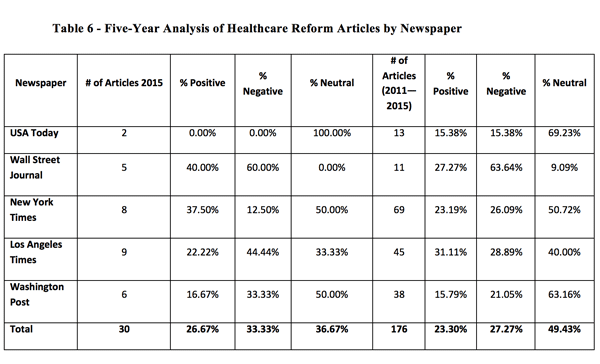
Comparing newspaper findings to other media
This year, for the first time, we supplemented our audit of major newspapers with analyses of transcripts of national network news broadcasts and searches on Google Trends and LexisNexis to incorporate a new dimension to our research. That is social listening and assessment of coverage by other media, such as radio and television. To do this, we investigated the same search terms over the study time period (October 1, 2014-September, 30, 2015) to learn whether the same “hot button” issues were identified by other media.
Coverage by other media included CBS, NBC, ABC, radio coverage, e.g., NPR, and social media, e.g., Google search. All made mention of the ethical issues identified by the newspapers in this year’s study. To explore this further, we reviewed three sources in depth, NBC Nightly News, NPR’s All Things Considered and Google. We restricted the three of them to the same study time period (10/01/14-09/30/15) as the newspaper study time period and learned that the 11 issues identified in the newspapers were also identified by the three other media sources. The findings are depicted in Table 7.
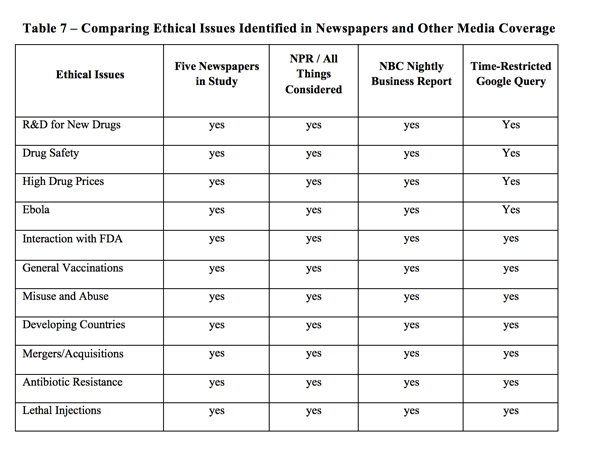
Then, we examined the scope of the coverage by the three other media sources. By volume, Google searches clearly identified a significant number of articles. Interestingly, when we searched “Ethical Issues Affecting the Pharmaceutical Industry between Oct 1st, 2014 and Sep 30th 2015”, there were 1,700,000 hits; the first “hit” was last year’s article in Pharmaceutical Executive, “Phar Exec’s 11th Annual Press Audit (“Media Coverage of Ethical Issues Affecting the Pharmaceutical Industry,” Google Search, accessed July 5, 2016). Furthermore, when we queried one of the 11 most reported issues, such as “high drug prices”, for the study-time period, there were 938,000 “hits” (“Coverage of High Drug Prices,” Google Search, accessed July 4, 2016 ).
Despite the number, many made only a cursory reference to the issue and/or referred the searcher back to other sources, such as one of the newspaper articles already covered by the newspapers’ assessment. For example, when we looked at “high drug prices”, the number three issue this year and top issue last year, we found it was covered around the same time as it was in the newspapers. While the coverage was across a broad range of sources, such as Oregon’s Medicaid coverage (“Coverage about High Drug Prices by Media Sources Other than Newspapers”, NBC Nightly Report, accessed July 5, 2016), it also referenced two newspaper articles already included in the study. These were the May 27th, 2015 Wall Street Journal front-page article, "New Push Ties Cost of Drugs to How Well They Work", and the June 14th, 2015 Los Angeles Times editorial, “Keeping the Pill Affordable”.
In addition to the most reported issues in newspapers, the other media sources also identified emerging issues, such as the exorbitant pricing of Daraprim® (pyrimethamine) for the treatment of toxoplasmosis (serious parasitic infection) by Turing Pharmaceuticals. While this issue was identified by newspaper articles, such as the September 24th, 2015 Washington Post front-page article, "Pricey Pill Is Rare Case of Transparency in Healthcare", the other media had coverage about this emerging issue sooner than the newspapers. Furthermore, in addition to being more timely, several of the other media sources, particularly NBC Nightly News and NPR’s All Things Considered had depth of coverage comparable to the coverage by newspapers..
This year’s preliminary findings suggest that there is definitely a correlation between coverage of ethical issues affecting the pharmaceutical industry by newspapers and by other media sources. The findings also suggest that not all media provide the depth of coverage provided by the newspapers and invites further comparison about the media sources, such as coverage in newspaper editorials and coverage by NPR. Additionally, the results also invite investigation about the audience’s retention of the information from the respective media sources.
Research indicates that comprehension of the information imparted is a function of the way the information is attained
(Varao Sousa, T.L., Carriere, J. S. A. and Smilek, D., “The Way We Encounter Reading material Influences How Frequently We Mind Wander,” Frontiers in Psychology, accessed July 3, 2016, ). There is an advantage to seeing the information in print and, consequently, listening and reading provided very different cognitive experiences. Participants listening to the information wandered significantly more than those reading it aloud and even more by those, who read silently. The listening group also scored worse on the memory test than the reading groups did (Varao Sousa, T.L., Carriere, J. S. A. and Smilek, D., “The Way We Encounter Reading material Influences How Frequently We Mind Wander,” Frontiers in Psychology, last modified November 28, 2013, http://www.fastcodesign.com/3026224/evidence/your-brain-on-audio-books-distracted-forgetful-and-bored).
Pharma is quite astute about the use of media other than newspapers for their promotional efforts and intended communication. However, this research may have implications for pharma about unintended consequences of other media coverage that addresses the ethical issues affecting the pharmaceutical industry. While we have demonstrated over the past 12 years that the pharma industry consistently gets this type of coverage in newspapers, it will be interesting to assess the lasting or not-so-lasting impression coverage is for those who are exposed to it.
Works cited
“Media Coverage of Ethical Issues Affecting the Pharmaceutical Industry,” Google Search, Accessed July 5, 2016, https://www.google.com/search?noj=1&biw=1438&bih=656&q=Ethics+Issues++affecting+the+pharmaceutical+industry+between+oct+1st%2C+2014+and+September+30th%2C+2015&oq=Ethics+Issues++affecting+the+pharmaceutical+industry+between+oct+1st%2C+2014+and+September+30th%2C+2015&gs_l=serp.12..35i39.39888.44173.0.47008.77.11.0.0.0.0.666.808.0j1j5-1.2.0....0...1c.1.64.serp..75.1.141.0.bWF1crdGLcM).
“Coverage of High Drug Prices,” Google Search, Accessed July 4, 2016 https://www.google.com/search?noj=1&biw=1438&bih=656&q=high+drug+prices+in+the+us+between+oct+1st%2C+2014+and+sep+30th%2C+2015&oq=high+drug+prices+in+the+us+between+oct+1st%2C+2014+and+sep+30th%2C+2015&gs_l=serp.12..30i10.181220.210325.0.216442.166.56.0.0.0.0.121.318.1j2.3.0....0...1c.1.64.serp..165.1.119.fW1HvB2kXIw.
“Coverage about High Drug Prices by Media Sources Other than Newspapers”, NBC Nightly Report, Accessed July 5, 2016, https://www.medicaid.gov/Medicaid-CHIP-Program-Information/By-Topics/Waivers/1115/downloads/or/or-health-plan2-ca.pdf.
Varao Sousa, T.L., Carriere, J. S. A. and Smilek, D., “The Way We Encounter Reading material Influences How Frequently We Mind Wander,” Frontiers in Psychology, last modified November 28, 2013, http://www.fastcodesign.com/3026224/evidence/your-brain-on-audio-books-distracted-forgetful-and-bored.
Reference
[1] The EthicsTrak database contains assessments of 1,874 newspaper articles evaluated over a 12-year period.
George P. Sillup, Ph.D., M.S., is Arrupe Fellow & Associate Professor, and Stephen J. Porth, Ph.D., is Associate Dean and Arrupe Fellow & Professor both of Saint Joseph's University (SJU), Philadelphia, PA. Cynthia Slater, SJU’s Business Reference Librarian and SJU Summer Scholar students, Dante Gleason, Caitlin Smith and Lauren Lang also contributed to this research.
Regeneron, Roche Launch Major US Expansion Plans to Meet Growing Demand for Biologics and Innovation
April 22nd 2025With combined investments exceeding $53 billion, both companies are deepening their US presence through expanded biologics production, gene therapy capabilities, and next generation R&D centers.
Cell and Gene Therapy Check-in 2024
January 18th 2024Fran Gregory, VP of Emerging Therapies, Cardinal Health discusses her career, how both CAR-T therapies and personalization have been gaining momentum and what kind of progress we expect to see from them, some of the biggest hurdles facing their section of the industry, the importance of patient advocacy and so much more.